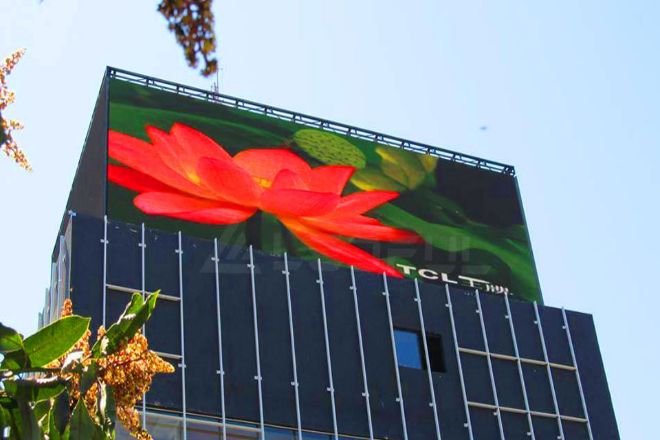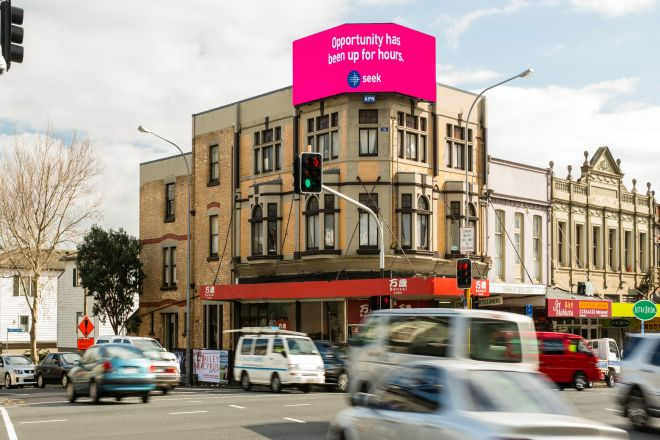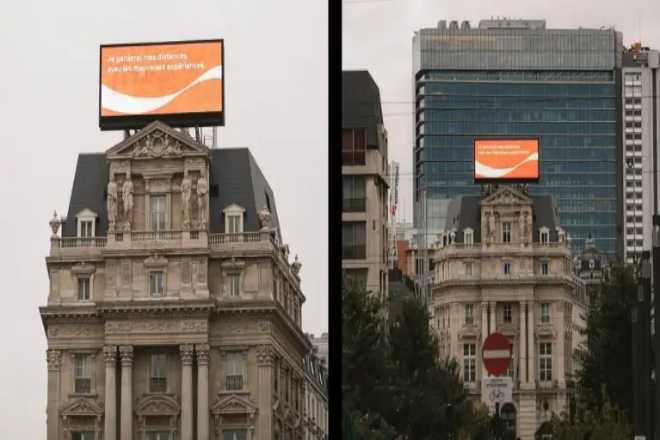Introducción

Have you ever seen pantallas LED installed on the roof? Many buildings that are not less than 10 floors like to install LED displays on the roof.
This not only saves space but also maximizes the viewing angle of the LED display. However, if the LED display is installed on the roof, there is a problem that must be considered: how to avoid lightning strikes.
1. Analysis of the hazards of lightning strikes to LED displays on the roof

1). The destructive power of instantaneous high voltage and high current generated by lightning strikes on electronic equipment
The lightning discharge voltage can be as high as thousands of kilovolts, and the instantaneous current is also very huge. This high voltage and high current have a huge destructive power on electronic equipment.
They can burn electrical equipment, such as generators, transformers, circuit breakers, etc., in the power system or break through the insulation of the transmission line and cause a short circuit.
The high temperature generated in the lightning channel often causes fires. At the same time, the thermal effect of lightning may also cause serious damage to the struck object or cause an explosion.
2). Rooftop LED screens are more susceptible to lightning strikes due to their high position
Rooftop LED screens are more likely to become targets of lightning strikes due to their high position, and the mounting brackets are mostly made of conductive materials such as iron.
Under frequent lightning or extreme weather conditions, the risk of lightning strikes on rooftop LED screens increases significantly.
3). Specific manifestations of possible damage to LED screens caused by lightning
Lightning damage to rooftop LED screens may take many forms, including but not limited to:
- Black screen:
Due to lightning hitting the screen or its surrounding structures, the power line or control system is damaged, making the screen unable to display normally.
- Burnout of lamp beads:
The high voltage and high current generated by lightning may directly hit the LED lamp beads, causing the lamp beads to burn out and affect the display effect.
- Daños a los componentes electrónicos:
The overvoltage generated by lightning may propagate to the LED advertising screen, damaging electronic components and circuits, such as burning, or damage to components, such as LED modules, power supplies, and controllers.
- Interferencia electromagnetica:
The strong electromagnetic field generated by lightning discharge may interfere with the normal operation of the LED advertising screen, causing abnormal image display, flickering, distortion, or failure to work properly.
2. What are the principles of lightning protection for rooftop LED screens?
Let’s talk about the principles of lightning protection for rooftop LED displays and those down-to-earth practical ideas.
1). The basic principles of lightning protection
1.1). Guide lightning into the ground:
This is the first principle of lightning protection. Guiding lightning to the ground can effectively avoid the direct impact of lightning on equipment such as rooftop LED displays.
Specific measures include installing lightning rods on the supporting structure of the rooftop LED display, which can attract lightning to itself and safely conduct current into the ground through down conductors.
1.2). Disperse lightning current:
When lightning strikes a building, through a reasonable grounding system and equipotential connection, the lightning current is dispersed underground, reducing the current density and reducing damage to the equipment.
Specific measures include establishing an equipotential connection between the steel structure of the rooftop LED display and the display housing to ensure that the current can be evenly distributed and conducted underground through a good grounding system.
Imagine if the lightning current flows underground like water through the “sewer” of the grounding system. Wouldn’t the equipment be safe? Equipotential connection is like putting a “bulletproof vest” on the equipment so that the current is evenly distributed and will not be concentrated on a certain point to cause damage.
1.3). Blocking the propagation path of lightning:
By installing lightning arresters, shielded cables, and other measures, the propagation path of lightning current is blocked to reduce the damage to the equipment caused by lightning.
For example, installing lightning arresters on the power lines and signal lines of the rooftop LED display can effectively prevent damage to the equipment caused by lightning overvoltage.
2). The importance of comprehensive lightning protection measures
Lightning protection cannot be solved by a single measure, and various factors must be considered comprehensively. For example, the location and height of the rooftop LED display, whether there are tall buildings around, etc., all of which will affect the choice of lightning protection measures.
If the display is in an open area and there are no tall buildings around, the threat of direct lightning is great. At this time, the lightning rod must come in handy, making it the “first choice” of lightning.
Various lightning protection measures must also cooperate with each other to form a complete lightning protection system. The lightning rod and the grounding system must “go hand in hand” to ensure that lightning can flow smoothly underground; the lightning arrester and the equipotential connection must also work side by side to resist the invasion of lightning overvoltage.
Finally, don’t forget to regularly inspect and maintain the lightning protection facilities, just like we have regular physical examinations. Lightning protection facilities must also be regularly inspected to ensure that they are all working properly.
If you find any problems, you must deal with them quickly and don’t let small problems become big problems.
In short, these are the principles of lightning protection for rooftop LED display screens. We must consider various factors according to the actual situation and choose appropriate lightning protection measures to ensure the safe operation of the display screen. Don’t think that lightning protection is a trivial matter. If you are really struck by lightning, the loss will be huge!
3. Specific lightning protection measures for rooftop LED display screens

For specific lightning protection measures for rooftop LED display screens, we have to talk about those practical and down-to-earth practices.
1). Install lightning rods or lightning strips
1.1). Working principle of lightning rod or lightning strip:
The lightning rod or lightning strip is like the “guardian” of the LED display on the roof. When lightning strikes, they will use their high tip to attract lightning, and then send lightning safely to the ground through the down conductor. In this way, lightning will not directly hit the display, protecting the safety of the display.
1.2). The necessity of installing a lightning rod or lightning strip at a suitable location on the roof:
The LED display on the roof is more likely to become a target of lightning because it stands high. Find a suitable location on the roof to install a lightning rod or lightning strip, just like holding up a “protective umbrella” for the display.
In this way, there is no need to be afraid of lightning because it will be guided underground by the lightning rod or lightning strip and will not harm the display.
2). Establish a complete grounding system
2.1). The importance of a grounding system in dispersing lightning current:
The grounding system is like a “diversion channel” for lightning. When lightning strikes a building, the grounding system can quickly disperse the lightning current underground so that the current will not be concentrated at a certain point and cause damage to the equipment.
A perfect grounding system is like a solid line of defense, protecting the building and the equipment inside.
2.2). Design and construction requirements of the grounding system:
When designing the grounding system, the structure of the building and the resistivity of the soil should be considered. During construction, ensure that the grounding body is in close contact with the soil and the grounding resistance is less than 10 ohms.
If the soil resistivity is too high and does not meet the requirements, you have to make an additional artificial grounding grid to make the grounding system more reliable.
3). Make equipotential connections
Equipotential connection means connecting all the metal objects in the building to make them a whole. In this way, when lightning strikes the building, all metal objects have the same potential, and there will be no potential difference, and no damage to the equipment.
3.1). How to connect the LED display screen and nearby metal objects to the same potential:
For the LED display screen on the roof, we can connect its metal shell, steel structure bracket, and nearby metal pipes with conductors.
When connecting, choose good materials such as copper busbars and flat steel to ensure that the connection is firm and reliable. Then, these equipotential connection conductors are connected to the grounding system to form a complete lightning protection system.
4). Use lightning protection equipment
4.1). The role and principle of lightning protection equipment such as lightning protection sockets and lightning arresters:
Lightning protection sockets and lightning arresters are like “bodyguards” for electrical equipment. When lightning overvoltage comes, they will quickly cut off the power supply or signal line to prevent lightning current from entering the equipment and causing damage.
Lightning protection sockets are generally used to protect electrical equipment on the sockets, while lightning arresters can be installed on power lines or signal lines as needed to provide comprehensive lightning protection.
4.2). The necessity of installing lightning protection equipment on power lines and signal lines:
The power lines and signal lines of the rooftop LED display are like the “lifeline” of the display. If lightning enters the display through these lines, it will cause damage to the display.
Therefore, installing lightning protection equipment on the power lines and signal lines is like adding a “fuse” to the “lifeline” of the display.
In this way, there is no need to be afraid of lightning because the lightning protection equipment will block the lightning overvoltage outside and protect the safety of the display screen.
4. Maintenance and inspection of lightning protection for rooftop LED display screen
The lightning protection facilities of the rooftop LED display screen are like its “guardian armor.” They must be taken care of and inspected frequently to ensure that they work safely and stably. Next, let’s talk about how to maintain and inspect these lightning protection facilities.
1). Regularly check the integrity of lightning protection facilities
Lightning rods and lightning strips, which are exposed to the outside, must be checked frequently to see if they are damaged by wind or rusted by rain. Especially those connected places, they must be tightened; don’t let them loose; otherwise, it will be troublesome when lightning comes.
The grounding system is the top priority, and its resistance is directly related to the lightning protection effect. Therefore, we have to use instruments to measure the resistance of the grounding system regularly to ensure that it meets the design requirements.
If the resistance is found to be large, we must quickly find the reason, whether it is not enough grounding bodies or the soil conductivity is not good, and then deal with it quickly.
2). Maintenance and replacement cycle of lightning protection equipment
Lightning protection sockets and lightning arresters will age and damage after long-term use. Therefore, we have to check them regularly to see if there are any abnormalities in appearance, such as discoloration, deformation, or burning.
According to the equipment’s instruction manual and the manufacturer’s recommendations, we have to set a maintenance and replacement cycle.
Generally speaking, lightning protection equipment should be inspected at least once a year, and if problems are found, they must be replaced quickly. Especially in places that are often struck by lightning, the frequency of inspection and maintenance should be higher.
3). Regular inspection of the LED display itself
The LED display is our “window” to see information. It must work normally for lightning protection measures to work. Therefore, we have to regularly measure the brightness, color, and resolution of the display to ensure that they are all normal.
We also have to check whether the power cord and signal cable of the display are firmly connected and whether there are any damaged or aged places. Those interfaces must especially be kept clean and dry to prevent moisture from getting in and causing short circuits.
Although ordinary users cannot directly check the internal circuits and components of the display, we can judge by observing the operating status of the display. If you find that the display screen is flashing, or there are abnormal phenomena such as a flowery screen and black screen, you must contact professionals for repair.
5. What are the precautions for lightning protection of rooftop LED display screens?

As an important device for outdoor information display, the lightning protection work of rooftop LED display screens should not be underestimated.
During installation, maintenance, and daily use, we need to pay special attention to some matters to ensure the safe operation of the equipment and protect our own safety. Next, let’s talk about the precautions for lightning protection of rooftop LED display screens.
1). Comply with safety regulations to prevent electric shock accidents
When installing rooftop LED display screens, the first thing we must ensure is safety. This is not only for the safety of the equipment but also for our own life safety.
Therefore, during the installation process, we must strictly abide by the electrical safety regulations to ensure that all wires and cables are wired correctly and well-insulated.
At the same time, we must use appropriate tools and protective equipment, such as insulating gloves, insulating shoes, etc., to prevent electric shock accidents during operation.
Maintenance should also not be careless. When checking, replacing lightning protection equipment, or performing other maintenance work on the display screen, be sure to cut off the power supply first to ensure that the equipment is in a power-free state.
Never operate under power because it is very easy to get an electric shock, and the consequences are disastrous.
2). Avoid operation and maintenance in thunderstorms
Thunderstorms are the most frequent lightning activities, and the rooftop LED display is most susceptible to lightning strikes. Therefore, in thunderstorms, we should try to avoid any operation and maintenance of the rooftop LED display.
On the one hand, in thunderstorms, lightning may invade the equipment through power lines, signal lines, etc., causing equipment damage. If we operate or maintain at this time, the risk of equipment damage may increase.
On the other hand, in thunderstorms, the outdoor environment is very bad, the visibility is poor, and the operation is also very dangerous. Once an accident occurs, the consequences may be very serious.
Therefore, for the sake of equipment and our safety, in thunderstorms, it is best to stay indoors and not risk going to the rooftop to operate and maintain the LED display. It’s not too late to go up when the weather gets better.
Conclusión
In summary, the lightning protection work of the rooftop LED display requires us to be vigilant at all times. During installation, maintenance, and use, safety regulations must be followed to prevent accidents such as electric shock.
At the same time, in thunderstorms, we try to avoid operating and maintaining the equipment to ensure the safety of the equipment and ourselves. Only in this way can we make the rooftop LED display better serve us.
Finalmente, si quieres saber más sobre las pantallas LED, Por favor póngase en contacto con nosotros.
